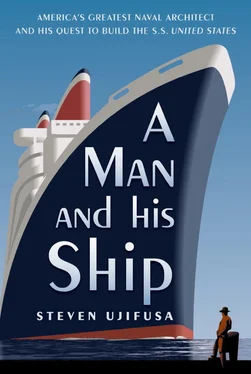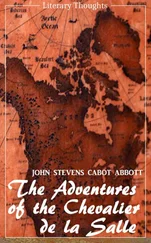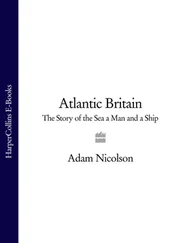IMM was put forward to American travelers and policy makers as a way to bring order to a chaotic shipping system routinely shaken by rate wars. Accordingly, Griscom argued that an international shipping monopoly would be a public benefit. “The object of combination is to try to give better transatlantic service at a decreased cost,” he said, and promised daily, on-time departures from New York to Europe. 38Yet rate stability (or as some asserted, driving competitors out of business) was not the only thing Morgan and Griscom wanted. Under the 1817 U.S. Navigation Act, only ships built in the United States could fly the American flag (and receive American subsidies). But it was still cheaper to build new ships abroad, and British-flagged vessels were much less expensive to staff and operate than American liners. Backed by Morgan’s capital, the huge combination could build larger and faster ships at a pace that independent lines could not match.
Morgan and Griscom nearly got things right. Within a few years, many transatlantic passenger lines sold out to the trust. In addition to Morgan and Griscom’s original American Line, IMM grew to include Belgium’s Red Star Line and four British lines: Leyland; Shaw Savill & Albion; Dominion; and the famed White Star Line.
The French and German lines were next on Morgan and Griscom’s list. The French Line was capable of resisting Morgan because it was a quasi-governmental agency. The two big German lines did not have such protection, although Kaiser Wilhelm II strongly supported keeping German ships German. So HAPAG’s cagey Ballin struck a deal to keep his company independent and maintain control over his highly profitable immigrant business. The German lines would be part of a profit-sharing arrangement with IMM, while also agreeing that neither party would acquire stock in the other’s enterprises. HAPAG and its rival Norddeutscher Lloyd would pay IMM a percentage of their dividends, and IMM would pay the two companies a fixed annual sum. The two sides agreed, in short, to take in each other’s laundry. 39
IMM’s $32 million buyout of the White Star Line caused an uproar with the British public. They saw Morgan as robbing Britannia of its prized commercial fleet, considered one of the Empire’s crown jewels. Not only that, but Morgan appointed White Star’s chairman, J. Bruce Ismay, the new president of IMM.
Britain’s one surviving big transatlantic line, the illustrious Cunard Steamship Company, refused to sell out, even though the company was strapped for capital. Chairman Lord Inverclyde “resolutely opposed any such absorption of the Cunard Line, which, more than any other, had become a national institution.” 40To keep IMM’s hooks out of Cunard, Inverclyde turned to British prime minister Balfour and the Admiralty for help. The company and the government agreed that “no foreigner shall be qualified to hold office as a director of the company or to be employed as one of the principal officers of the company; and no shares of the company shall be held by, or in trust by, or be in any way under the control of any foreigner or foreign corporation, or any corporation under foreign control.” 41Now Britain’s greatest transatlantic shipping company was Morgan-proof.
More help would be needed for Cunard to compete against Morgan’s clout, and the British nation supplied it. Cunard received a low-interest government loan of £2.6 million to construct two large, fast passenger liners in British yards. 42Each ship would be 790 feet long and of 30,000 gross tons, making them a third larger than any of their German competitors. In addition, the Admiralty would pay Cunard a handsome operating subsidy of £150,000 per year. Cunard, for its part, agreed that should war ever break out, the two superliners could be taken over by the Admiralty and converted into armed merchant cruisers. This would make the ships not only the biggest, fastest liners ever, but warships in disguise. There was little protest from British taxpayers; national honor was at stake. 43
Cunard got to work building what would be the two greatest ships in the world. Their keels were laid in 1904 and they were launched in 1906. Both were christened with imperial-sounding names: Lusitania, after the Roman province of Portugal, and Mauretania, after the Roman province of North Africa.
A year later, William Francis Gibbs, free of college and accompanied by his brother, Frederic, was going to sail on both of them. Somehow, in spite of their family’s financial problems, they got enough money out of their father for round-trip tickets to Europe.

3. MAURETANIA
On November 7, 1907, the Swan, Hunter & Wigham of Newcastle, England, shipyard team took the new Cunard flagship Mauretania out on her trial runs. Captain John Pritchard made a series of twelve-hour runs, up and down a 304-mile course along the Scottish coast. The new ship and crew fought fierce Atlantic winds, rising at one point to a force 7 gale, or wind speeds approaching 40 miles an hour. On the bridge, Mauretania ’s chief designer, Andrew Laing, hovered closely around Captain Pritchard. After two runs with the wind and two against, Laing was jubilant. Over the course of nearly forty-eight hours, the four-funneled Mauretania had averaged 26.06 knots over 1,216 nautical miles. 1This was nearly three knots faster than her German rivals.
The Scotsman Laing, the most accomplished marine engineer in Great Britain, had designed engines for record-breaking Cunarders for the last twenty-five years. He wanted this ship to take back the Blue Riband. His feeling was shared by Mauretania ’s entire crew, from the officers on the bridge to the sweat-drenched stokers heaving coal into the ship’s furnaces below. It was not, now, a matter of beating the Germans. One month earlier, on only her second run, Mauretania ’s sister ship Lusitania (designed by Leonard Peskett and built by the rival John Brown yard in Scotland) had taken the Blue Riband—twice: eastbound, besting Norddeutscher Lloyd’s Kaiser Wilhelm II; and westbound, beating HAPAG’s Deutschland.
The crew of Mauretania felt that they had the better ship. “We’ll lick the Lucy, ” cried one of the stokers as he clanked his shovel against the boiler grate on the delivery run from Newcastle to Southampton, “even if we bust the Mary to do it!” 2
Nine days after the trial runs, on November 16, 1907, William Francis and Frederic Gibbs leaned over Mauretania ’s railings. As a hard rain fell, they looked up and down the Liverpool landing stage and saw it crowded with thousands of waving, cheering well-wishers.
They had been part of such a scene before, when they left New York on her sister Lusitania less than one month before. Although they had traveled on big ships as children, these Cunard liners set a new standard for size and luxury. The Gibbs brothers relished the newness and thrilled at the speed of Lusitania. They ran all over the ship, probably comparing her to the blueprints of the British warships William Francis had stashed in his dorm room. While other passengers remained in the warmth of the ship’s paneled Georgian salons, he spent hours with the wind whipping in his face, leaning over the railing and watching Lusitania ’s knifelike prow cut through the gray Atlantic at nearly 30 miles an hour.
Now, on the westbound maiden voyage of the bigger, more powerful Mauretania, they hoped to see another record fall. This crossing would be one to remember.
Читать дальше













